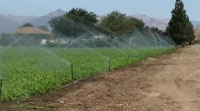 |
NASA | GSFC | JPL | Site Map |
|
|
 |
 |
Education: Student Outcomes |
Click here to search for other assets Water, Water Everywhere: Human Impacts on Water Storage Grade level: 9-12 Theme: water cycle Video: water_everywhere_03.flv
Matt Rodell: "An aquifer is any underground geologic formation that stores water so it's typically either rock with a lot of cracks in it, or it's (a) sandy layer. Sand has a lot of pore space in it and can store a lot of water." A water molecule might remain in an aquifer for more than a million years. More likely, it would help to replenish a stream, which would feed into lakes and rivers. Eventually, the water molecule will return to where it started: the ocean. People also have a role in the water cycle. By pumping water out of the ground for irrigation, cutting down forests for development and building roads and other concrete surfaces that lead to runoff, people can have a serious impact on the path a water molecule takes. Matt Rodell: "The most obvious way that people affect the water cycle are the ways that we control the water after it's fallen on the land surface as rain or melts as snow... But we have put in dams and rivers to hold this water. We've also pumped the groundwater out and used that. So it's these water resources, as we call them, are really us taking a natural part of the water cycle and using it to our benefit." Student Outcomes After viewing this video, students should be able to: Determine if global precipitation, evaporation, and the cycling of water are changing. (W: 9-12) Key: C = climate / O = ocean circulation / T = 21st century technology / W = water cycle |
|||||
